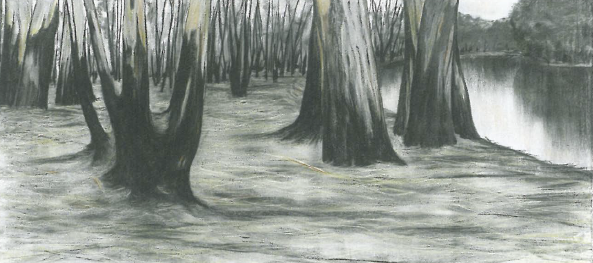
The continuing influence of land (scape) on artists was evidenced at the 2004 Adelaide Festival, including the Adelaide Biennial of Australian Art, Holy, Holy, Holy at the Flinders University City Gallery and the William Robinson show at the University of South Australia Art Museum. Concurrent with the Adelaide Festival, Mildura (the closest city of reasonable size to Adelaide) was holding its own Arts Festival that also featured a strong visual arts component.
I chose to review Antonia Chaffey's In The Vein because it illustrated the rewards and pitfalls associated with the land as subject and metaphor.
Antonia Chaffey, who trained at the South Australian School of Art, is the great granddaughter of W. B. Chaffey, one of the founders of irrigation in Australia and an iconic figure in Mildura and the South Australian Riverland. This connection is important to the artist and one that has provided stimulus for critical reflections on the nature of exploitation and development on a fragile land. Chaffey spent six months in the Mildura region prior to mounting In The Vein, which, according to the artist, should be 'read' as a narrative.
I took her advice and progressed around the exhibition, beginning with Locus Meridian 143, a small work depicting one of the key sites of the artist's fieldwork. Utilising charcoal, pastel and ochre on rice paper and a map with grid lines, this piece indicates 'the locus of the landscape around Euston on the river Murray where the floodplain species of Eucalyptus camaldulensis (river red gum) and Eucalyptus largiflorens (black box) still stand after several hundred years'. Thus informed, I started my journey.
Along the way I was confronted by an array of different styles and mediums in various formats ranging from tiny pieces resembling fragments of old maps to large abstract canvasses. Latin titles - a poetic language and a metaphor for forgetting according to the artist – provided clues. Locus in quo, for example, means 'a place where a trespass has been committed', and refers to illegal logging near Paiko Creek.
Strata, one of the few early pieces, was from Petra in Jordan (1992) where the artist began her 'desert' series of paintings following an archaeological trip to the Middle East after the first Gulf war. Singula (meaning detail) revealed the dermis of a burnt tree trunk. Macula (stain) referred to the effects of salination as a result of agriculture. These relatively small works were followed by two large charcoal studies of trees (both titled Locus in quo), then two large colour field paintings (Proxime ad Lake Tyrrell 1 and Proxime ad Lake Tyrrell 2), which took cues from the brilliant scars wrought upon the land by horticulture.
By this time certain devices became apparent, including the use of staining. Indeed, staining, or scarring, appeared in one form or another in most works. Chaffey's earth seems feminine. Traces of distress, like the stains of woman's blood on a night sheet, indicate places where the earth has suffered. I particularly liked the small works utilising stains that spread into patterns over which the artist had little control. These were gentle but evocative works. Chaffey's trees, on the other hand, seemed hard and brutal, as if they were inserting themselves into, or rising out of the ground.
Continuing on, I pass Psyche's Final Task II, a large acrylic on canvas whose title referred to the myth of Psyche. Non dimenticarmi (Italian for 'don't forget me'), a tiny watercolour on Chinese paper, depicted a tree at the eroded banks of the river whose roots became further exposed with each passing flood.
The tiny shrine-like Venus of Mungo incorporated a shell fossil referencing the feminine and the corporeality of nature. This private piece, which was not for sale, stopped me in my tracks. Until this point I'd encountered many different kinds of pictures that made for an interesting narrative. This piece, however, seemed more personal. It was almost as if I should not be looking at it. Women's business, maybe?
From that point on the exhibition assumed a museum-like quality, especially in the works based on Howitt's S E Australia maps, and the Mutawintji set of small ochre and watercolour pieces alluding to 19th Century field note-taking. It was as if, after the obsessive qualities of what had passed, I had come to a kind of debriefing.
The final work was called Listen, which I had been doing all along. This was not so much a didactic statement as a wish by the artist for understanding the world we live in and are, increasingly, destroying.












